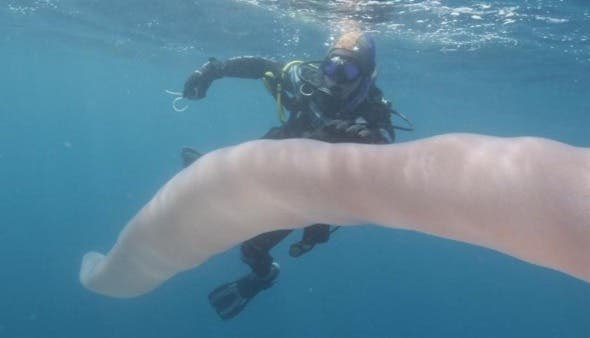Strange, 26-foot-long, giant sea worm found by divers
What would typically lead most people to flee the water was something the two guys quickly recognized as completely safe and uncommon.

[June 20, 2022: Miguel Brown]
Two divers came across a spectacular sight while swimming off the coast of New Zealand. (CREDIT: Steve Hathaway)
It was a pyrosome, large enough for him to swim across, and he'd been hoping to see one for years. What would typically lead most people to flee the water was something the two guys quickly recognized as completely safe and, in fact, an uncommon occurrence.
Buttle describes swimming around it as "was pretty incredible," "We could see hundreds of thousands of tiny creatures right up close."
This is because a pyrosome is a free-flowing colony of hundreds or thousands of individual creatures known as zooids. Zooids are tiny multicellular organisms that filter feed by pushing water through their body and collecting phytoplankton, bacteria, animal feces particles, and anything else they can clean up.
Because they pump water into one siphon and out the other, they are classified as tunicates, sometimes known as "sea squirts." What about another moniker? "Sea cockroaches," for their capacity to filter food out of even the most hostile conditions.
Pyrosome and Salp
According to Andrew Jeffs, professor of marine science at the University of Auckland, the pyrosome and its cousin, the salp, are both "hugely important and super abundant" as a food source in mostly tropical seas. Both are sustenance for sea animals such as turtles and spiny lobsters, Jeffs' specialty.
Related Stories:
Predators may cling to the tubes and dine for weeks. It's like hanging off an elephant and eating it," he adds. "They can afford to take the time and nibble on enough to get the goodness from them." However, animals frequently die as a result of ingesting plastic bags that resemble them or other gelatinous creatures such as jellyfish.
Pyrosomes eat by swimming vertically to the ocean surface at night to capture phytoplankton and then returning to the depths when daylight arrives, maybe to avoid predators that feed during the day.
The 26-foot Sea Worm
The pyrosome is a tubular, gelatinous substance that glows due to spontaneous bioluminescence. They can be as little as a centimeter in size or as large as (or larger than) the one in the video. Salps, which are formed up of one zooid and are more frequent, have received more attention than pyrosomes. In 2017, the West Coast saw a massive pyrosomine.
Summer's warmer temperatures attract a variety of aquatic creatures. "Around this time of year, you always see something new," Hathaway adds. He'd seen enough aquatic life in his 11-year cinematography profession, including manta rays and whales. He and Buttle ended up swimming about the pyrosome for almost forty minutes this time.
He plans to incorporate this expertise into his educational entertainment platform for children, Young Ocean Explorers. "I'm sure the kids will enjoy it," he says. "It appears to them to be a massive worm. Sometimes it takes something unusual to bring people to a halt."
Note: Materials provided above by Miguel Brown. Content may be edited for style and length.
Like these kind of feel good stories? Get the Brighter Side of News' newsletter.
Joseph Shavit
Head Science News Writer | Communicating Innovation & Discovery
Based in Los Angeles, Joseph Shavit is an accomplished science journalist, head science news writer and co-founder at The Brighter Side of News, where he translates cutting-edge discoveries into compelling stories for a broad audience. With a strong background spanning science, business, product management, media leadership, and entrepreneurship, Joseph brings a unique perspective to science communication. His expertise allows him to uncover the intersection of technological advancements and market potential, shedding light on how groundbreaking research evolves into transformative products and industries.



